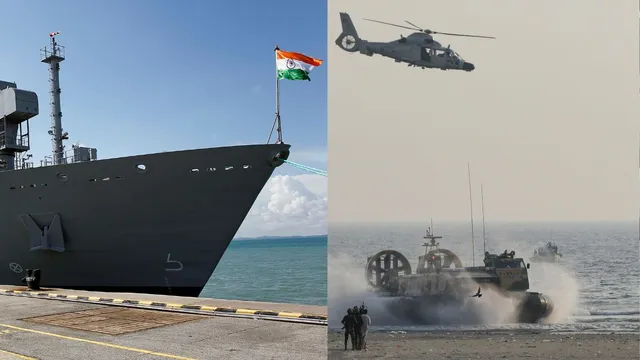- By Shivangi Sharma
- Mon, 28 Apr 2025 07:57 PM (IST)
- Source:JND
India and France have solidified a major defence agreement with the purchase of 26 Rafale fighter jets for the Indian Navy. This deal makes India the first international operator of the naval variant of the Rafale, highlighting the deepening strategic ties between the two countries. The decision follows India’s selection of the Rafale Marine in July 2023, after careful evaluation of the aircraft's capabilities.
The timing of this deal is particularly significant as tensions between India and Pakistan have escalated following the recent Pahalgam terror attack. Calls for military action against Pakistan have gained momentum, with a naval blockade being one of the options under discussion—an approach India successfully employed in the 1971 war to cripple Pakistan. This raises a critical question: how capable is the Pakistani Navy in the Arabian Sea, and how much of a threat does it pose to India’s naval supremacy in the region?
Pakistan’s Naval Strength: A Comparison With India
While the Pakistani Navy is certainly a key component of the country’s military strength, it pales in comparison to India’s naval capabilities. In terms of global naval rankings, Pakistan’s navy sits at 27th, while India boasts a much higher position at 6th. Let’s take a closer look at the strengths of both navies.
Fleet Size And Composition
The Pakistani Navy operates a fleet of 121 ships, significantly fewer than India’s 293. This disparity places India in a much stronger position when it comes to sheer fleet strength. India’s navy also enjoys a considerable advantage in terms of variety and sophistication.
ALSO READ: ISRO, NASA Finalise NISAR Launch Preparations; Indian Astronaut To Join Mission | Details Inside
Aircraft Carriers: A Decisive Advantage
One of the most notable differences between the two navies is the presence of aircraft carriers. The Pakistani Navy does not possess a single aircraft carrier and lacks the experience to operate one. In contrast, India operates two aircraft carriers: INS Vikramaditya and INS Vikrant. These carriers not only enhance India's strategic mobility but also increase its ability to project power over long distances, especially in the Indian Ocean.
Submarine Strength: A Key Factor
Submarines are a crucial element of naval warfare, and here, the gap between India and Pakistan is striking. The Pakistani Navy operates 8 diesel-electric submarines, which are conventional and do not have the capability to carry nuclear weapons. On the other hand, India has 18 submarines, including two nuclear-powered submarines: INS Arihant and INS Arighat. The INS Arihant, commissioned in 2016, is a nuclear-powered ballistic missile submarine, providing India with a significant advantage in strategic deterrence. Additionally, India is in the process of developing INS Aridhaman, a third nuclear-powered submarine.
India’s Superior Naval Power
India’s navy is clearly much larger and more capable than Pakistan’s. With a fleet of 293 ships compared to Pakistan’s 121, India dominates in terms of overall fleet strength. In addition to its aircraft carriers, India’s fleet includes 18 submarines, 13 destroyers, 14 frigates, 18 corvettes, and 135 patrol vessels. Pakistan, in comparison, only has 9 frigates, 9 corvettes, and 69 patrol vessels. Moreover, India’s naval power projection capabilities, such as its aircraft carriers and nuclear-powered submarines, give it a significant strategic advantage in the Arabian Sea.
ALSO READ: Centre Rebukes BBC For Referring To Terrorists As 'Militants' In Pahalgam Attack Coverage
Naval Balance Of Power
The balance of naval power in the Arabian Sea overwhelmingly favours India. While Pakistan’s navy is an important asset for the country, it simply cannot compete with India’s larger and more advanced fleet. Should tensions escalate further, particularly in light of the Pahalgam attack, India’s superior naval capabilities would likely play a decisive role in any military confrontation. The suggestion of a naval blockade against Pakistan could have a substantial impact, just as it did in the 1971 war.

